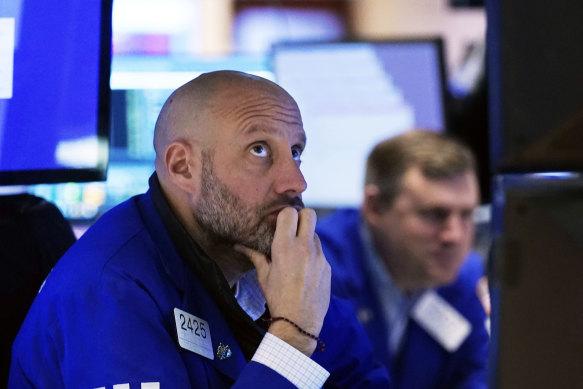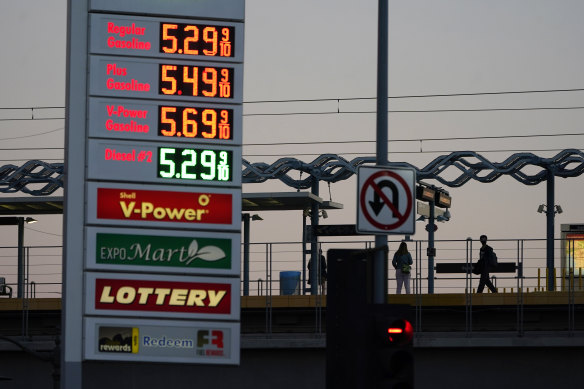This was published 1 year ago
Opinion
Why the ‘higher for longer’ interest rates call could be misleading
Stephen Bartholomeusz
Senior business columnistMarkets have taken to heart last week’s Federal Reserve Board signal that US interest rates would remain higher for longer. Could it, however, be a false signal or, have the Fed and investors perhaps reached the right conclusion based on the wrong premises?
After the tone in the Fed’s commentary – and that of its chair, Jerome Powell – proved even more hawkish than the markets had anticipated, US bond yields spiked to 16-year highs and the S&P 500 fell 2.4 per cent, with the tech-heavy and rate-sensitive Nasdaq index slumping 3 per cent, before the markets stabilised on Monday.

Wall Street slumped last week on the back of the Fed’s interest rates signal. Credit: AP
Investors had hoped for, if not a rate cut by the end of this year, then the start of an unwinding of the Fed’s 11 rate rises over 18 months in the first half of next year.
They responded predictably to the Fed’s message that there was likely to be at least one more rate rise this year and then, at best, only two 25 basis point reductions in the latter part of next year – rather than the four that markets had priced in.
As the post-pandemic cycle of rising rates in response to rising inflation has moved closer to its end than its beginning, however, the apparent strength of the Fed’s convictions is potentially misleading.
Given the lags between monetary policy actions and results, the final phase of a cycle is tricky. Central banks tend to err on the side of conservatism and overkill and this particular cycle has novel features.
Inflation rates that reached decades highs were generated by the supply-side shocks flowing from a once-in-a-century pandemic. The responses of central banks and their governments was unprecedented, with enormous amounts of fiscal and monetary stimulus.
Inflation rates are now tracking down, albeit more slowly than central bankers might have hoped, but are doing so in an environment laden with multidimensional risks that could either rekindle inflation or plunge economies into recession.
Central bankers are operating in a particularly murky environment, which means the risk of a misjudgment is probably even greater than in the past.
One of the curious developments in the US in this period has been how resilient the US economy has been in the face of such a rapid and significant increase in interest rates and the steady withdrawal of liquidity as the Fed shrinks a balance sheet bloated by its response to the pandemic.
US consumer spending has held up remarkably well despite the twin impacts of inflation and the higher interest rates.
That may, however, be due to the government largesse in response to the pandemic, when households were showered with cash.
In most of the major economies, where similar programs were effected, there are signs that the big boosts to household savings have been unwound and consumers are now starting to feel the pinch even though, in the US, the Biden administration continues to operate with expansive fiscal policies.
Consumer and business loans taken out during the near-zero interest rate environment of the pre-pandemic decade are also steadily maturing and being refinanced at dramatically higher rates. Commercial real estate markets in the US are showing signs of stress and housing market activity has fallen.
The surge in oil prices to around $US94 a barrel, with some forecasts they will breach $US100 a barrel, will add to the mounting pressure on households and businesses.
The US has some other quite specific challenges. It is, thanks to the hardliners in the Republican Congress, on the verge of a federal government shutdown that would force the Biden administration to shut down many of its functions and agencies and stand down large numbers of federal employees, costing the economy an estimated $US6 billion a week.
Moody’s Investor Services, the only major credit ratings agency to have maintained America’s AAA rating, has warned that a shutdown would highlight the weakness of US governance and the constraints that the intensifying politicisation is imposing on US policymaking at a time of declining fiscal strength and deteriorating debt affordability.
The US government deficit is expected to double, to $US2 trillion this financial year (the US financial year starts on October 1) and approach 7 per cent of GDP.

High fuel prices are going to put the squeeze on consumers around the world.Credit: AP
Federal government debt has just passed $US33 trillion – about 95 per cent of GDP – and the steep rise in interest costs will absorb an increasing proportion of federal revenues and eventually force Congress into substantial and contractionary cuts to spending.
In the meantime, the deficits have to be funded and maturing debt refinanced. After the impasse over the US debt ceiling was resolved in May, when the US Treasury was forced to run down its cash reserves, it estimated that the refinancing task in the December half would amount to about $US2.8 trillion.
That’s not a one-off. Over the next 18 months or so, nearly a third of all Treasuries – more than $US30 trillion – will mature.
With the Fed, previously the major buyer, now shrinking its balance sheet, that deluge of supply will by itself almost guarantee that US market rates will remain higher than they might otherwise have been and for longer than might otherwise have been the case.
Central bankers are operating in a particularly murky environment, which means the risk of a misjudgment is probably even greater than in the past.
The looming shutdown, an autoworkers strike that will impact vehicle production and potentially drive up costs, and the imminent resumption of repayments on student loans after a pandemic-inspired three-year moratorium will also affect activity.
Then there are the external risks, including the slowdown in China’s economy, the continuing “de-risking” of Western supply chains to reduce their dependence on China and the war in Ukraine.
There are, therefore, conventional reasons to think that the Fed’s message that rates will remain higher for longer – which resulted in the yields on two-year Treasury notes creeping up and those on 10-year bonds jumping 18 basis points – might be challenged by the confluence of threatening events.
The contrary view, albeit not one that the Fed has adopted publicly, is that the real interest rate that balances savings and investment to deliver full employment within an economy operating at close to its potential, with stable inflation rates, is higher today than it was pre-pandemic, when the central bankers’ concern was that “neutral” rates were so low they threatened economic stagnation.
While it’s an academic concept, and estimating the neutral rate more of a calculated guess than something that is observable, an increase in the neutral rate would support the “higher for longer” thesis – as would the challenge of attracting the demand to absorb the deluge of supply of US government debt – albeit not for the reasons that have caused the Fed to embrace it.
The Fed is operating on the premise that it will take higher interest rates for a longer period to slow the economy and bring the US inflation rate back to its two per cent target, after which it will start lowering them.
It may be that where US rates – bond market yields and the pricing of credit rather than the federal funds rate – settle over the next year or so is, however, ultimately less to do with inflation than other, less conventional, factors that return rates to not merely their pre-pandemic settings but something closer to pre-2008 financial crisis norms.
The Market Recap newsletter is a wrap of the day’s trading. Get it each weekday afternoon.